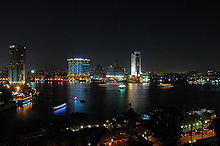Economy of Egypt

|
|
| Currency | Egyptian Pound (EGP) |
|---|---|
|
Trade organisations
|
WTO, CAEU and COMESA |
| Statistics | |
| GDP |
$1.047 trillion (PPP; 2015) $330.765 billion (nominal; 2015) |
| GDP rank | 32nd (nominal) / 24th (PPP) |
|
GDP growth
|
2.9% (2014), 4.4% (2015), 4.3% (2016e), 4.0% (2017f) |
|
GDP per capita
|
$11,850 (PPP; 2015 est.) $3,740 (nominal; 2015 est.) |
|
GDP by sector
|
agriculture: 11.2%, industry: 36.3%, services: 52.5% (2015 est.) |
| 19.4% (November 2016) | |
|
Population below poverty line
|
26% (2015) |
| 30.8 (2013) | |
|
Labour force
|
28.4 million (March 2016) |
|
Labour force by occupation
|
agriculture: 29%, industry: 24%, services: 47% (2011 est.) |
| Unemployment | 12.7% (March 2016) |
|
Main industries
|
textiles, food processing, tourism, chemicals, pharmaceuticals, hydrocarbons, construction, cement, metals, light manufactures |
| 122nd (2017) | |
| External | |
| Exports | $20.88 billion (2015 est.) |
|
Export goods
|
crude oil and petroleum products, cotton, textiles, metal products, chemicals, agricultural goods |
|
Main export partners
|
|
| Imports | $57.91 billion (2015 est.) |
|
Import goods
|
machinery and equipment, foodstuffs, chemicals, wood products, fuels |
|
Main import partners
|
|
|
FDI stock
|
$89.65 billion (2015 est.) |
|
Gross external debt
|
$46.1 billion (2015) |
| Public finances | |
| 88% of GDP (June 2015) | |
| Revenues | $70 billion (2015) |
| Expenses | $100.8 billion (2015) |
| B- (Domestic) B- (Foreign) B- (T&C Assessment) (Standard & Poor's) |
|
|
Foreign reserves
|
$26.36 billion (January 2017) |
$1.047 trillion (PPP; 2015)
$11,850 (PPP; 2015 est.)
The economy of Egypt was a highly centralized planned economy focused on import substitution under President Gamal Abdel Nasser. In the 1990s, a series of International Monetary Fund arrangements, coupled with massive external debt relief resulting from Egypt's participation in the Gulf War coalition, helped Egypt improve its macroeconomic performance.
Since 2000, the pace of structural reforms, including fiscal, monetary policies, taxation, privatization and new business legislations, helped Egypt move towards a more market-oriented economy and prompted increased foreign investment. The reforms and policies have strengthened macroeconomic annual growth results which averaged 8% annually between 2004 and 2009 but the government largely failed to equitably share the wealth and the benefits of growth have failed to trickle down to improve economic conditions for the broader population, especially with the growing problem of unemployment and underemployment. After the 2011 revolution Egypt's foreign exchange reserves fell from $36 billion in December 2010 to only $16.3 billion in January 2012, also in February 2012 Standard & Poor's rating agency lowered the Egypt's credit rating from B+ to B in the long term.
In 2013, S&P lowered Egypt's long-term credit rating from B- to CCC+, and its short-term rating from B to C on worries about the country's ability to meet its financial targets and maintain social peace more than two years after President Hosni Mubarak was overthrown in an uprising, ushering in a new era.
Egypt has a rather stable mixed economy enjoying average growth, averaging 3%–5% in the past quarter-century. The economy embarked on various stages of development during which the public and private sectors played roles varying in relative importance as follows:
The Egyptian economy is still suffering from a severe downturn following the 2011 revolution and the government faces numerous challenges as to how to restore growth, market and investor confidence. Political and institutional uncertainty, a perception of rising insecurity and sporadic unrest continue to negatively affect economic growth.
...
Wikipedia
